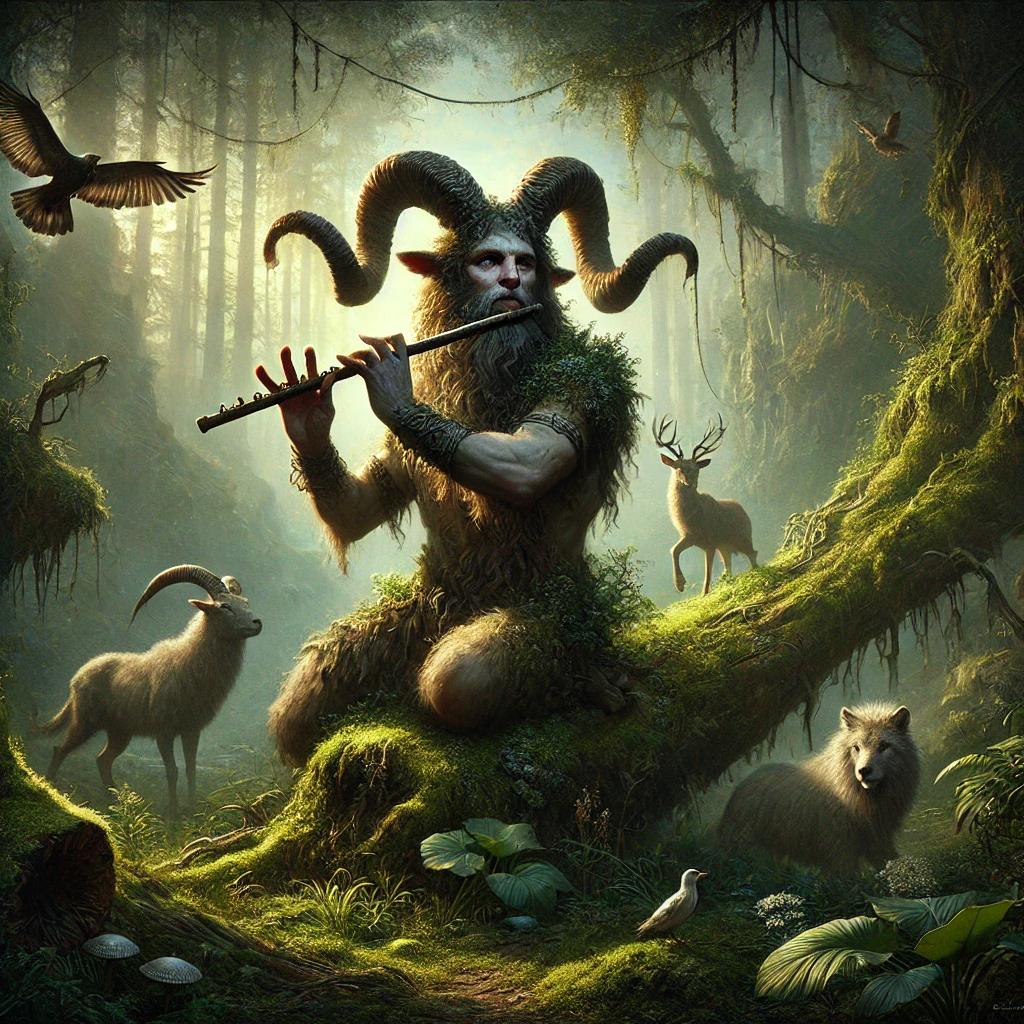Overview
Pan is a powerful and ancient nature deity from Greek mythology, widely revered as the god of the wild, shepherds, flocks, rustic music, and untamed nature. With the legs and horns of a goat and the upper body of a man, Pan symbolizes the primal, fertile, and instinctive forces of the natural world. He embodies the spirit of wilderness, spontaneity, and earthy sensuality, often dwelling in forests, mountains, and secluded groves. As a wild spirit, Pan bridges the divide between the civilized world and the raw, vital energies of Earth.
Though originally a pastoral deity, Pan’s essence transcends shepherds and herds—he is a guardian of sacred nature, the whisper in the wind, the pulse of life in untamed lands, and a reminder of humanity’s deep-rooted connection to the Earth.
Origins and Mythology
1. Greek Roots
- In Greek mythology, Pan is the son of Hermes and a woodland nymph (or sometimes other deities, depending on the tradition).
- He was born with goat legs, horns, and a full beard, a form that caused others to fear or laugh—but was embraced by nature itself.
- Pan’s name may be linked to the word “pan” meaning “all,” suggesting a universal life force—a being who is everywhere and in everything.
2. Association with Nature and Fertility
- Pan was worshipped in the wilds rather than in temples, especially in Arcadia, his sacred homeland.
- He is associated with springtime, sexual vitality, music (especially the pan flute or syrinx), and the regenerative forces of the Earth.
Spiritual Significance of Pan
1. The Archetype of Wildness
- Pan represents wildness untamed by civilization—the raw instincts, the mystery of the forest, and the magic of nature unshaped by human hands.
- His energy teaches that freedom, intuition, and presence are vital parts of a spiritually connected life.
2. Earth Connection and Fertile Vitality
- As a fertility god, Pan represents life force, passion, and physical embodiment, encouraging wholeness through connection to one’s body, sexuality, and natural instincts.
- His presence is often felt in liminal spaces—sun-dappled glades, secluded meadows, and threshold moments between night and day, human and divine.
3. Shadow and Awe
- Pan is also associated with panic—his sudden appearance in remote places was said to inspire terror (from which we get the word “panic”). This reflects the fear and awe often experienced in wild, uncontrolled encounters with nature’s raw power.
Symbols and Associations
| Symbol | Meaning |
|---|---|
| Pan Flute (Syrinx) | Intuitive expression, musical inspiration |
| Goat | Fertility, instinct, independence |
| Forests & Groves | Sacred wild places, thresholds, mystery |
| Spring & Meadows | Renewal, vitality, natural abundance |
| Mountains | Ancient wisdom, primal power |
Working with Pan Energetically
1. Nature Immersion
- Pan is best honored in natural, undisturbed places—woods, hills, and meadows.
- Spending time barefoot in nature, listening to the sounds of birds, water, and wind, and moving freely in wild spaces can open a channel to Pan’s essence.
2. Music and Movement
- Pan is invoked through music, dance, and uninhibited expression. Playing music outdoors, dancing around a fire, or moving in tune with natural rhythms honors his joyful, ecstatic presence.
3. Grounding and Reconnection
- As a spirit of embodiment, Pan reminds us to come back to the body and senses. Grounding practices—like lying on the earth, conscious breathing, or mindful movement—help attune to his energy.
- Offerings such as nuts, wine, bread, or wildflowers can be left in natural spaces in his name.
Modern Relevance of Pan
- In today’s world, Pan represents the need to reconnect with nature and reclaim our wild, intuitive selves.
- He reminds us that divinity is not only found in the heavens, but also in soil, bark, wind, laughter, and desire.
- Pan also serves as a symbol of environmental awakening, encouraging the defense of wilderness and natural freedom against the encroachment of modernity.
Conclusion
Pan is not merely a figure from ancient mythology—he is a living archetype, a spirit of Earth’s vitality that continues to echo in forests, groves, and the deep instincts of our being. As a guardian of wild nature, Pan invites us to celebrate life, rewild our spirits, honor the body, and remember our sacred roots in the living Earth. By listening to the wind, dancing with the trees, and surrendering to joy and presence, we awaken to the call of Pan—the eternal, untamed spirit of Nature itself.

